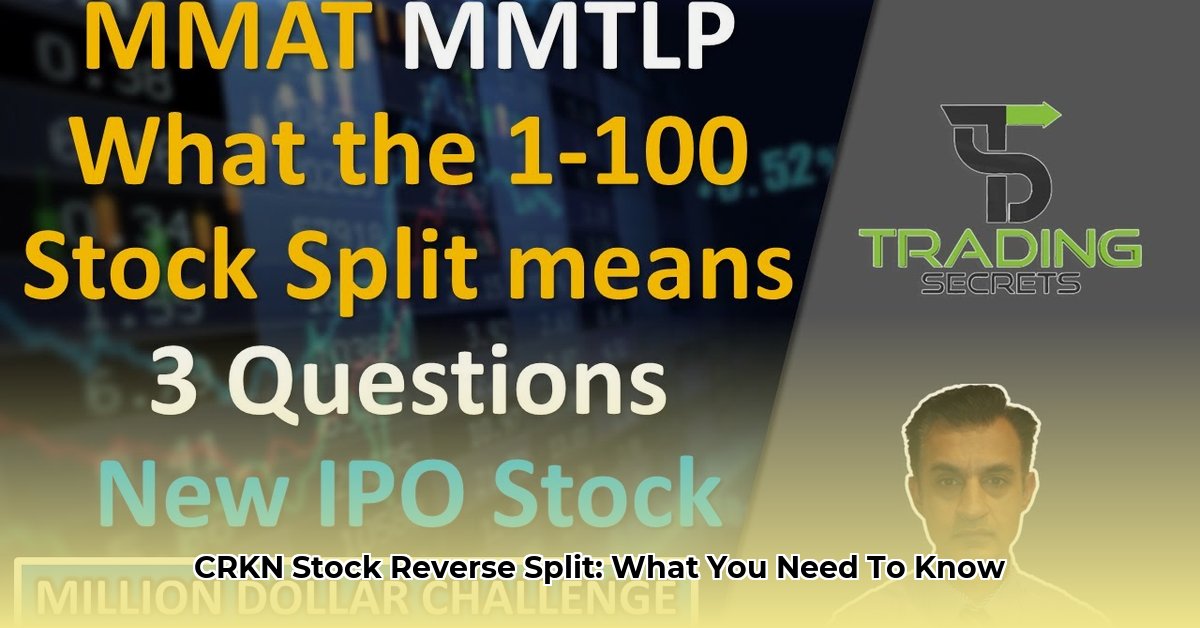
Crown Electrokinetics (CRKN) executed a reverse stock split in 2023 (1:60) and again in 2025 (1:150), significantly reducing the number of outstanding shares. This article analyzes the implications of these actions for investors, examining the rationale, potential benefits and drawbacks, and providing actionable insights.
Understanding the CRKN Reverse Stock Splits
A reverse stock split consolidates existing shares into fewer, higher-priced shares. CRKN cited compliance with Nasdaq listing requirements as the primary reason, aiming to avoid delisting due to a persistently low share price. However, the impact extends beyond mere compliance, influencing investor perception and market liquidity. Did this action address fundamental issues, or simply mask underlying problems? This is a key question investors must consider.
The Mechanics and Rationale
The reverse split, as a corporate action, doesn't fundamentally alter the company's intrinsic value. It's a restructuring maneuver affecting the number of shares, aiming to artificially inflate the price per share. While a higher share price might attract institutional investors, it's crucial to remember that this is not a sudden indicator of improved financial health or enhanced product quality. The underlying business performance remains the ultimate determinant of long-term success. What questions should investors be asking about CRKN's long-term viability?
Weighing the Pros and Cons
The primary goal of the reverse split was to increase the share price and enhance the company's attractiveness to potential investors. However, this action has both potential positives and significant negatives.
Potential Positives:
- Higher Share Price: A higher share price may attract larger institutional investors who often avoid low-priced stocks.
- Nasdaq Compliance: Meeting Nasdaq's minimum price requirements ensures continued listing on the exchange, maintaining access to capital markets.
Potential Negatives:
- Reduced Liquidity: Fewer shares available for trading can decrease market liquidity, leading to higher price volatility and making it more difficult for investors to buy or sell shares at desired prices.
- No Impact on Fundamentals: The reverse split doesn't improve the company's profitability, efficiency, or underlying business model. It's a structural change, not a performance enhancement.
- Alienation of Smaller Investors: Smaller investors might end up with fractional shares, which can be an inconvenience.
Impact on Different Investor Groups
The reverse split affects various investor groups differently. How does the change in share structure impact investor strategies?
- Smaller Investors: These investors may face the most immediate challenges from fractional shares and reduced liquidity, increasing transaction costs.
- Large Institutional Investors: These investors are generally less affected, holding sufficient shares to minimize the impact of the split.
- CRKN Management: While a higher share price may improve investor perception, it also intensifies pressure to deliver demonstrable improvements in performance.
Short-Term and Long-Term Impacts
The following table summarizes the potential short-term and long-term impacts on various stakeholders:
| Stakeholder Group | Short-Term Impact (0-1 year) | Long-Term Impact (3-5 years) |
|---|---|---|
| Current Shareholders | Potential share price fluctuations, reduced liquidity, fractional share adjustments. | Company performance will ultimately dictate the success or failure of the strategy. |
| Potential Investors | Assessment of CRKN's financial health and growth prospects; liquidity concerns. | Long-term outlook and growth potential will dictate investment decisions. |
| CRKN Management | Improved market perception (potentially), increased pressure to demonstrate improved results. | Sustained revenue growth and improved profitability is essential. |
| Nasdaq | Temporary compliance with listing requirements. | N/A |
Assessing the Risks
Several significant risks are associated with the reverse split:
| Risk Category | Probability | Impact | Mitigation Strategies |
|---|---|---|---|
| Reduced Trading Volume | High | Medium | Improved investor relations and increased market activity are crucial. |
| Share Price Volatility | Medium | High | Diversification and robust risk management are essential for investors. |
| Negative Investor Sentiment | Medium | Medium | Transparency and clear communication from CRKN are necessary. |
| Failure to Meet Nasdaq Requirements (again) | Low | High | Sustained financial stability and demonstrable revenue growth. |
Conclusion: A Long-Term Perspective
CRKN's reverse stock split is a complex event with both potential benefits and inherent risks. The ultimate success hinges not on the share price, but on the company's ability to deliver sustained profitability and growth. Investors should conduct thorough due diligence, focus on the fundamentals, and adopt a long-term perspective for informed decision-making. The share price increase may be temporary; real value is created only through sustained, long-term performance.